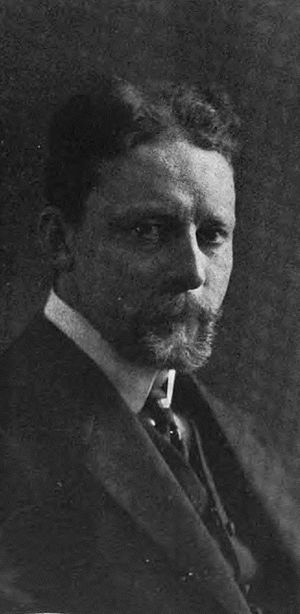Franz Karl Ginzkey facts for kids
Quick facts for kids
Franz Karl Ginzkey
|
|
|---|---|
 |
|
| Born | 8 September 1871 Pula |
| Died | 11 April 1963 (aged 91) Vienna |
| Occupation | Officer and writer |
| Awards |
|
Franz Karl Ginzkey (born September 8, 1871, in Pula, now Croatia; died April 11, 1963, in Vienna) was an Austrian officer, poet, and writer. He is best known for his children's book Hatschi Bratschis Luftballon (Hatschi Bratschi's Balloon), which has been loved by many generations of children.
Contents
Franz Karl Ginzkey's Early Life and Career
Franz Karl Ginzkey's father was an officer in the Austrian Navy. Franz Karl himself joined the imperial army and served until 1897. During his time in the army, he was sometimes in charge of the Hohensalzburg Fortress, which was used as barracks.
From 1897 to 1914, Ginzkey worked as a mapmaker at the Military Geographic Institute in Vienna. After that, he worked in the war archives. In 1920, he retired from the military and became a full-time writer.
Ginzkey's Involvement in Politics and Friendships
During a challenging political period in Austria (from 1934 to 1938), Ginzkey was a member of the Council of State, representing artists. After 1938, he became involved with the political leaders of the time.
He was good friends with other famous writers like Max Mell and Stefan Zweig. He also knew artists such as Faistauer Anton and Carl Zuckmayer. Ginzkey helped start the famous Salzburg Festival and was on its board for many years. From 1944 onwards, he lived in Seewalchen, a town near Lake Attersee.
Honoring Franz Karl Ginzkey
Franz Karl Ginzkey is buried in a special "grave of honor" at the Vienna Central Cemetery. On his 100th birthday in 1971, a monument was built in his memory in Seewalchen, near Lake Attersee.
Ginzkey is considered one of the "new romantic" poets and novelists. A famous writer named Peter Rosegger was one of the first to recognize Ginzkey's talent. Many of Ginzkey's works are connected to the city of Salzburg.
Works Connected to Salzburg
Some of Ginzkey's writings that show his connection to Salzburg include:
- Wie ich Herr auf Hohensalzburg ward (When I was master at Hohensalzburg)
- Altsalzburger Bilder nach 10 Federzeichnungen (Old Salzburg Images after 10 Pen Drawings), created with Ulf Seidl
- Jakobus und die Frauen (Jacob and the Women, 1908)
- Der seltsame Soldat (The Strange Soldier, 1925)
- Der Heimatsucher (The Home Seeker, 1948)
- Das Antlitz Salzburgs (The Face of Salzburg, 1933)
- Salzburg und das Salzkammergut (Salzburg and the Salzkammergut, 1934)
- Prinz Tunora (Prince Tunora, 1934)
- Salzburg, sein Volk und seine Trachten (Salzburg, its People and its Costumes, 1934)
In 1968, a square in Salzburg was named Ginzkeyplatz in his honor. It is located in the Salzburg-Süd district, between Alpenstrasse and Adolf-Schemel-Strasse.
Selected Literary Works
Here are some of Franz Karl Ginzkey's most well-known books and poems:
- Hatschi Bratschis Luftballon, 1904 (His famous children's book)
- Der von der Vogelweide, 1912
- Der Wiesenzaun. Erzählung (The Meadow Fence. A Story), 1913
- Die Front in Tirol (The Front in Tyrol), 1916
- Der Gaukler von Bologna, Roman (The Juggler of Bologna, Novel), 1916
- Befreite Stunde. Neue Gedichte (Liberated Hour. New Poems), 1917
- Der Doppelspiegel. Betrachtungen und Erzählungen (The Double Mirror. Reflections and Stories), 1920
- Rositta, 1921
- Der Prinz von Capestrano (The Prince of Capestrano), 1921
- Die Reise nach Komakuku. Geschichten aus seltsamer Jugend (The Journey to Komakuku. Stories from a Strange Youth), 1923
- Der Kater Ypsilon. Novellen (The Cat Ypsilon. Novellas), 1926
- Florians wundersame Reise über die Tapete (Florian's Wonderful Journey Across the Wallpaper), 1931
- Gespenster auf Hirschberg. Aus der hinterlassenen Handschrift des Majors von Baltram (Ghosts on Hirschberg. From the Manuscript Left by Major von Baltram), 1931
- Das verlorene Herz. Ein Märchenspiel (The Lost Heart. A Fairy Tale Play), 1931
- Magie des Schicksals. Novelle (Magic of Fate. Novella), 1932
- Liselotte und ihr Ritter oder Warum nicht Romantik? (Liselotte and Her Knight or Why Not Romance?), Roman, 1936
- Der selige Brunnen. Eine Raphael Donner-Novelle (The Blessed Well. A Raphael Donner Novella), 1940
- Zeit und Menschen meiner Jugend (Time and People of My Youth), 1942
- Taniwani. Ein fröhliches Fischbuch (Taniwani. A Cheerful Fish Book), 1947
- Genius Mozart, 1949
- Die Geschichte einer stillen Frau, Roman (The Story of a Quiet Woman, Novel), 1951
- Der Träumerhansl (Dreamer Hansl), 1952
- Altwiener Balladen (Old Viennese Ballads), 1955
Awards and Honors
Franz Karl Ginzkey received several important awards for his literary work:
- 1921: Adolf Mejstrik Prize for poetry from the German Schiller Foundation
- 1932: Honorary doctorate from the University of Vienna (meaning he was given a special university degree to honor his achievements)
- 1941: Ring of Honour of the City of Vienna
- 1954: Literary Prize of the City of Vienna
- 1957: Grand Austrian State Prize for Literature, shared with Heimito von Doderer
- 1957: Austrian Decoration for Science and Art
- Ring of the city of Salzburg

